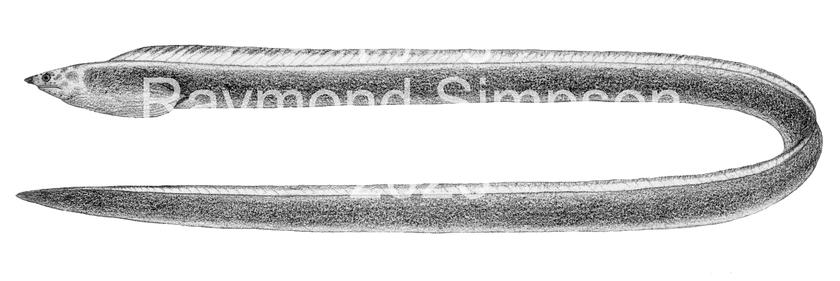
Common Name
Sailfin Eel
Year Described
Goode & Bean, 1882
Identification
Vertebrae: 136-144
Body elongate and compressed. Trunk much longer than tail (tail only 36-42% of TL). Snout pointed laterally, bluntly rounded dorsally, and overhangs mouth. Underside of snout without median groove. Eye small and around middle of jaw. Mouth very small. Anterior nostril a simple flush hole (not tubular). Posterior nostril opens into mouth. Teeth slender and pointed. Maxillary biserial (8-13 outer and 2-8 inner teeth). Lower jaw with 17-23 teeth in a single row. Intermaxillary with two rows of 6-13 teeth. Vomer with 0-6 teeth. Gill openings crescent-shaped, low on body and converging anteriorly. Gill pouch inflated and grooved. Dorsal fin origin on top of head, elevated in front and ending well short of tail tip. Anal fin absent. Pectoral and caudal fins absent. Tail tip hard and pointed. Lateral line complete. Suborbital pores 4. Supraorbital pores 4.
Color
Body and head dark brown, with lateral pores being paler in color. Belly pale. Dorsal fin contrastingly pale, sometimes with a dark edge.
Size
Maximum size to 57.8cm TL.
Habitat
Found on soft bottoms from 0-90m.
Range
North Carolina to NE Gulf of Mexico
References
Böhlke, E. B. (ed.). 1989. Volume One: Orders Anguilliformes and Saccopharyngiformes. Volume Two: Leptocephali. Fishes of the western North Atlantic. Memoirs of the Sears Foundation of Marine Research Mem. 1 (part 9): v. 1:i-xvii + 1-655; 2:i-vii + 657-1055.
McCosker, J. E. 1974. A revision of the ophichthid eel genus Letharchus. Copeia, 619-629.
Other Notes
The two Atlantic species, even ignoring the assumption of geographic separation, are separable by vertebral counts and coloration pattern.